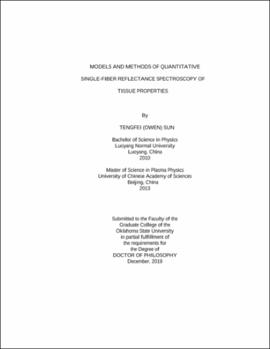| dc.contributor.advisor | Piao, Daqing | |
| dc.contributor.author | Sun, Tengfei (Owen) | |
| dc.date.accessioned | 2020-06-26T21:27:56Z | |
| dc.date.available | 2020-06-26T21:27:56Z | |
| dc.date.issued | 2019-12 | |
| dc.identifier.uri | https://hdl.handle.net/11244/324880 | |
| dc.description.abstract | Single-fiber reflectance spectroscopy has unique clinical applications not amendable to other types of spectroscopy technologies when assessing a very small tissue domain. SfRS aims to quantify light propagation in the sub-diffusive regime by using a detection geometry that has the illumination and collection areas completely overlapped. This work presents models and methods of diffuse reflectance spectroscopy in a sub-diffusive domain that may be translated to single fiber reflectance spectroscopy (SfRS) measurements at steady-state and time-domain. By using Monte Carlo simulations and analytical approaches, this work specifically analyzes diffuse reflectance associated with a center-illuminated and area-collection round geometry (CIAC) that reveals patterns salient to SfRS, including the dependence on scattering anisotropy and scattering coefficient at low-scattering region, and independence on scattering over high-scattering region. Operating in this CIAC geometry with the tissue modeled as a semi-infinite homogeneous medium, this work demonstrates a few methods that are new to the modeling of diffuse reflectance at the scales relevant to SfRS: (1) two models of spatially-resolved diffuse reflectance applying to a scale as small as 10-5 of the reduced scattering pathlength that is two orders smaller than previously modeled are developed, (2) the total diffuse reflectance as the measurement is developed by taking the integration of the spatially resolved diffuse reflectance over the entire area of collection, (3) the analytical results reveal quantitatively the saturation level and the transition shoulder point that have been observed in steady-state SfRS measurements but without explanations. The analytical modeling approach demonstrated for steady-state measurements is also extended to time-revolved measurement for assessing the effect of absorption and scattering changes on the measurements. These models will be useful to rapid inversion for recovering tissue optical properties based on diffuse reflectance at a single-fiber scale. | |
| dc.format | application/pdf | |
| dc.language | en_US | |
| dc.rights | Copyright is held by the author who has granted the Oklahoma State University Library the non-exclusive right to share this material in its institutional repository. Contact Digital Library Services at lib-dls@okstate.edu or 405-744-9161 for the permission policy on the use, reproduction or distribution of this material. | |
| dc.title | Models and methods of quantitative single-fiber reflectance spectroscopy of tissue properties | |
| dc.contributor.committeeMember | Bunting, Charles F. | |
| dc.contributor.committeeMember | O'Hara, John | |
| dc.contributor.committeeMember | Wang, Ning | |
| osu.filename | Sun_okstate_0664D_16582.pdf | |
| osu.accesstype | Open Access | |
| dc.type.genre | Dissertation | |
| dc.type.material | Text | |
| dc.subject.keywords | diffusion | |
| dc.subject.keywords | model | |
| dc.subject.keywords | optical spectroscopy | |
| dc.subject.keywords | single fiber | |
| dc.subject.keywords | steady-state | |
| dc.subject.keywords | time-domain | |
| thesis.degree.discipline | Electrical Engineering | |
| thesis.degree.grantor | Oklahoma State University | |
